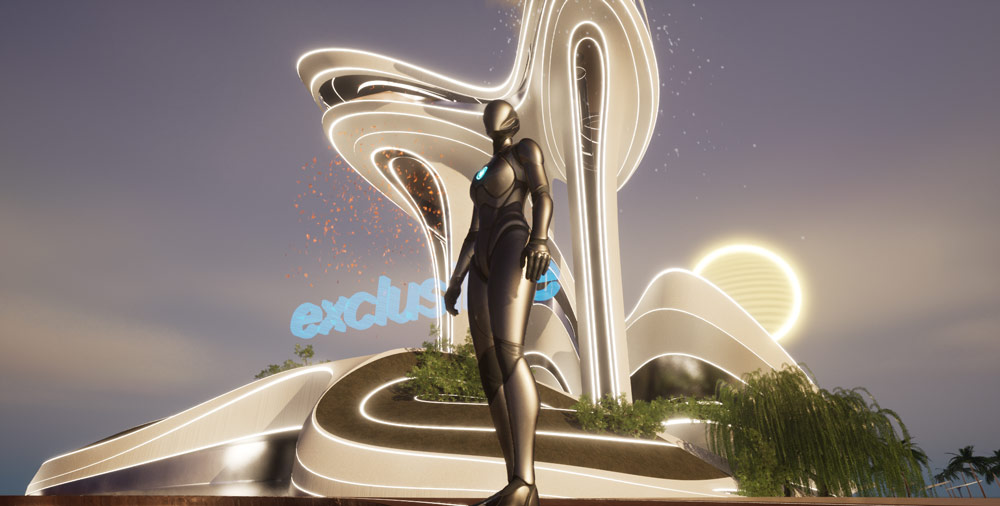The Seasons was designed by Bruno Charles, Ines Pereira, Maritza Rubio, and Teisla Klein as part of PAACADEMY‘s “Meta-Fluid Studio 2.0” with Mariana Cabugueira.
They wanted to ensure that the project aligned with the client’s vision for promoting their brand in the luxury market and connecting physical and digital products. From there, they began brainstorming ideas for how to promote well-being and a quality stay for the users of the building, drawing inspiration from the sophisticated and high-quality partners of the client. This informed their overall goal to design a unique and exclusive building for the users.
The starting point of their project was to capture the beauty and perfection of natural forms in their building design. The team wanted to create a connection between the building and the changing seasons, using this as a way to link people with the positive feelings and sensations of being in nature such as happiness, joy, and relaxation.
They divided the design process into three parts:
Concept design: The team created mood boards on Miro to capture the client’s interests and used these as inspiration for their ideas.
3D modeling: They used Maya Autodesk to model the concept and evolved the design through several iterations and reviews during studio reviews.
Project upload: They uploaded the project to Unreal, where they added visual and sound effects to bring motion and dynamism to their project.
Software and Modelling
The team used Maya for the modeling of the project. According to the team, Maya is a powerful tool for modeling that helped us to define the shape of the project, and its intuitive ways of modeling allowed them to be more creative in our design. It allowed them to create complex shapes and forms, and also to make adjustments and changes to the design easily and efficiently.
Additionally, Maya’s wide range of modeling tools and features such as polygon, NURBS, and sub-division surface modeling helped them to create a detailed and high-quality 3D model of the building.
Visualization
For visualization, they used Unreal Engine. According to the team, Unreal Engine is a powerful tool for creating high-quality 3D environments and real-time visual effects. They used it to create the final images and video recordings of the project. Unreal Engine allowed them to add materials, lighting, and effects to the 3D model and create a realistic and immersive representation of the building.
Additionally, Unreal Engine’s real-time rendering capabilities allowed them to preview the project in a lifelike way and make any adjustments necessary. For post-processing, they used Photoshop and Premiere Pro to fine-tune the final images and videos. They used Photoshop for color correction, retouching, and adding final details, and Premiere Pro for color grading, composition, and creating the final animation.
The infinite possibilities of creating materials and effects in Unreal Engine helped them to enhance their original idea of bringing nature to the project and designing something that allows the user to feel comfortable while exploring their proposal. The real-time rendering capabilities of Unreal Engine allowed them to preview the project in a lifelike way, make adjustments, and fine-tune the final images and videos. It also helped us to create more realistic and dynamic visual effects such as lighting and shadows, reflections, and post-processing effects that added to the overall realism and immersion of the final project.
Key Features
One key feature of this project that they want to highlight is the way they integrated nature into the design of the building. They were inspired by the beauty and perfection of natural forms and used this as a starting point for the project. They connected the building with the seasons of the year and used this as a tool to link people with the positive feelings and sensations of being in nature such as happiness, joy, and relaxation.
To achieve this, they used a variety of techniques and tools, such as the use of natural materials, and the integration of greenery and water features. They also used light and color in a way that mimics the natural environment, and incorporated features such as balconies and terraces that encourage outdoor living and connection with nature. They also used sound effects to simulate the natural ambiance.
The use of Unreal Engine to create materials, textures, assets, and effects helped us to bring this idea to life in a realistic and immersive way, allowing the users to feel comfortable while exploring our proposal.
Conclusion
In conclusion, The Seasons was a challenging and exciting endeavor that aimed to capture the beauty and perfection of natural forms in architectural design. Theyused a variety of techniques and tools to integrate nature into the design of the building and create a connection between the building and the changing seasons. They used natural materials, greenery, and water features to bring a sense of nature into the building, and incorporated features such as balconies and terraces to encourage outdoor living and connection with nature.
They used Maya for the modeling of the project, which helped them to define the shape of the project, and its intuitive ways of modeling allowed them to be more creative in their design. According to the team, they used Unreal Engine for the visualization of the project, it allowed them to create high-quality 3D environments and real-time visual effects and helped them to give personality to the project.
Overall, they believe that this project represents a unique and innovative approach to architectural design, and they are proud of the result that they achieved. They hope that this building will be a source of inspiration and enjoyment for the users, and will help to promote a connection with nature in an urban environment.
If you are interested in exploring the quality and power of Fluid Design to conceive cyber-urban environments in virtual cities, this studio is for you: Join us at Meta-Fluid Studio 3.0!

























Leave a comment